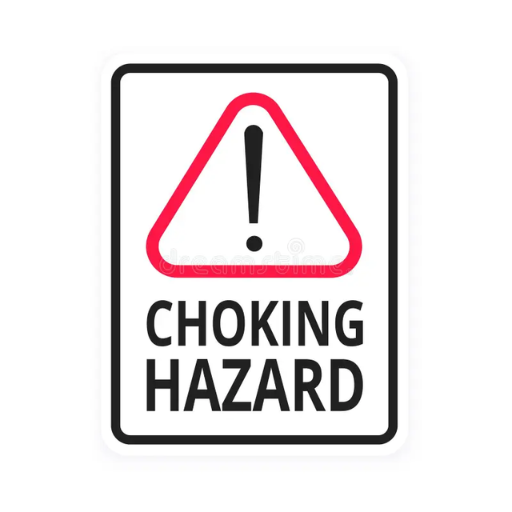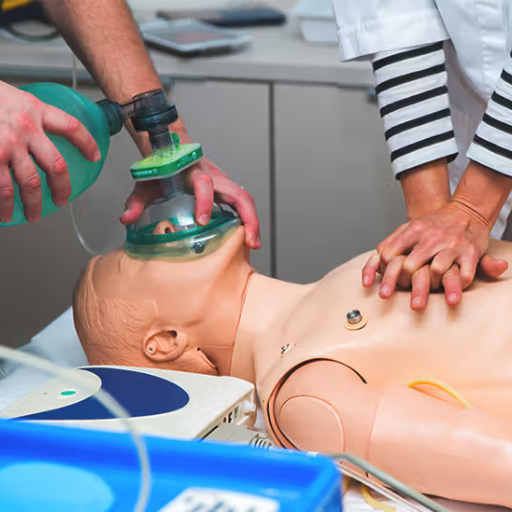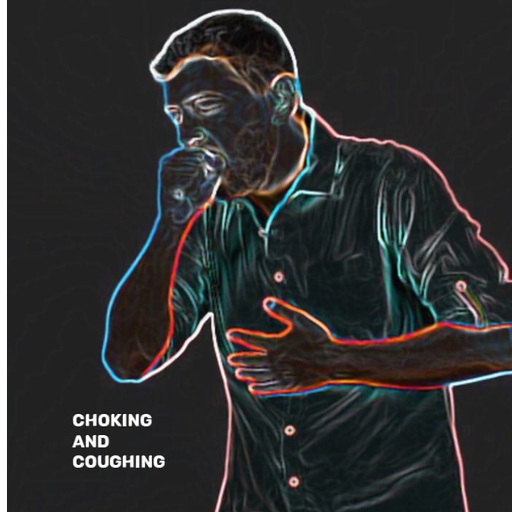
Choking deaths present a great social risk since they happen suddenly and unexpectedly. In this blog, I intend to address the factors responsible for the risk of choking and suggest approaches to help reduce the risk. The primary focus of the discussion of the primary issue will be the demographics and the situations surrounding such events that assist in the improvement of safety and preparedness. Anticipating dangers and risks is critical to saving lives, whether during routines like eating, during rest, or in more dangerous and specific situations. We will also consider the phenomenon of choking on food, the social groups most affected by the phenomenon, and the possible courses of action to enable individuals and the community at large to respond to incidences of choking on food.
 A choking hazard can best be defined as any item, be it an object or foodstuff, which may pose a serious threat of asphyxiation by blocking the airways of a person. As a general rule of thumb, such hazards are small enough to be sucked in or sit within one's throat, thus preventing respiration. A few examples of choking hazards would be foods such as nuts, popcorn, bananas, and hotdogs, as well as toys, small parts, marbles, coins, buttons, and the like. Vulnerable to such risks are children younger than four years of age, as their swallowing system is still maturing, and they have an inherent tendency to put objects in their mouths. The understanding of these hazards is very important in avoiding situations where a person eats and chokes, thus risking their life.
A choking hazard can best be defined as any item, be it an object or foodstuff, which may pose a serious threat of asphyxiation by blocking the airways of a person. As a general rule of thumb, such hazards are small enough to be sucked in or sit within one's throat, thus preventing respiration. A few examples of choking hazards would be foods such as nuts, popcorn, bananas, and hotdogs, as well as toys, small parts, marbles, coins, buttons, and the like. Vulnerable to such risks are children younger than four years of age, as their swallowing system is still maturing, and they have an inherent tendency to put objects in their mouths. The understanding of these hazards is very important in avoiding situations where a person eats and chokes, thus risking their life.
 The National Safety Council and other safety associations state that choking is one of the top-ranking external unintentional injury causes. In the US, choking causes approximately 5,000 to 6,000 deaths each year. It should be pointed out that children and old people are the two populations who are most at risk of choking hazards. The number of such tragic incidents can be brought down by creating awareness and taking preventive measures.
The National Safety Council and other safety associations state that choking is one of the top-ranking external unintentional injury causes. In the US, choking causes approximately 5,000 to 6,000 deaths each year. It should be pointed out that children and old people are the two populations who are most at risk of choking hazards. The number of such tragic incidents can be brought down by creating awareness and taking preventive measures.

 Preventing instances of choking emergencies calls for a well-rounded effort that takes into account education, supervision, and changes in the environment. Educating parents about dangerous objects within children’s reach, as well as emphasizing the necessity of appropriate toys and foods for children’s age, becomes pivotal in reducing the risks. Also, adequate supervision of children, such as during eating and activities when many small, certainly swallowable objects may be within reach, is imperative. Supervision of children can also be made easier by adjusting the surroundings to be more child-friendly to mobiles or other objects that may lead to accidental choking. Training the caregivers in first aid, as well as CPR, can also help curb the hurting effects posed by choking threats to victims when supervision fails. The final line of defense against choking emergencies is vigilant actions, preparedness, and firm resolutions.
Preventing instances of choking emergencies calls for a well-rounded effort that takes into account education, supervision, and changes in the environment. Educating parents about dangerous objects within children’s reach, as well as emphasizing the necessity of appropriate toys and foods for children’s age, becomes pivotal in reducing the risks. Also, adequate supervision of children, such as during eating and activities when many small, certainly swallowable objects may be within reach, is imperative. Supervision of children can also be made easier by adjusting the surroundings to be more child-friendly to mobiles or other objects that may lead to accidental choking. Training the caregivers in first aid, as well as CPR, can also help curb the hurting effects posed by choking threats to victims when supervision fails. The final line of defense against choking emergencies is vigilant actions, preparedness, and firm resolutions.
 According to my professional experience in assisting a person in circumstances of emergency, the point that has to be taken into account first while dealing with a choking victim is to check for the level of panic the person is likely to be in and the level of copious obstruction that is present. If the individual is capable of some communication and is able to breathe, then you should motivate him or her to cough in order to expel the object. If there is no ventilation or phonation, this is an indication of an almost total blockage. In such a case, remove the obstruction by utilizing the back-slapping techniques and forceful thrusts of the abdomen, which are popularly known as the Heimlich maneuver. Stand behind the person, and with the heel of your hand, deliver five sharp video thrusts between the shoulder blades. If the maneuver fails, grasp your fist above the person’s waist and thrust toward the diaphragm, forcing it inward and upward. It is necessary to emphasize the need to repeat this sequence of actions until the rescue operation is over. Please inform the paramedics as soon as possible if this condition is excessive or if self-clearing has not been successful since further restraints may be required.
According to my professional experience in assisting a person in circumstances of emergency, the point that has to be taken into account first while dealing with a choking victim is to check for the level of panic the person is likely to be in and the level of copious obstruction that is present. If the individual is capable of some communication and is able to breathe, then you should motivate him or her to cough in order to expel the object. If there is no ventilation or phonation, this is an indication of an almost total blockage. In such a case, remove the obstruction by utilizing the back-slapping techniques and forceful thrusts of the abdomen, which are popularly known as the Heimlich maneuver. Stand behind the person, and with the heel of your hand, deliver five sharp video thrusts between the shoulder blades. If the maneuver fails, grasp your fist above the person’s waist and thrust toward the diaphragm, forcing it inward and upward. It is necessary to emphasize the need to repeat this sequence of actions until the rescue operation is over. Please inform the paramedics as soon as possible if this condition is excessive or if self-clearing has not been successful since further restraints may be required.
What is a Choking Hazard?
 A choking hazard can best be defined as any item, be it an object or foodstuff, which may pose a serious threat of asphyxiation by blocking the airways of a person. As a general rule of thumb, such hazards are small enough to be sucked in or sit within one's throat, thus preventing respiration. A few examples of choking hazards would be foods such as nuts, popcorn, bananas, and hotdogs, as well as toys, small parts, marbles, coins, buttons, and the like. Vulnerable to such risks are children younger than four years of age, as their swallowing system is still maturing, and they have an inherent tendency to put objects in their mouths. The understanding of these hazards is very important in avoiding situations where a person eats and chokes, thus risking their life.
A choking hazard can best be defined as any item, be it an object or foodstuff, which may pose a serious threat of asphyxiation by blocking the airways of a person. As a general rule of thumb, such hazards are small enough to be sucked in or sit within one's throat, thus preventing respiration. A few examples of choking hazards would be foods such as nuts, popcorn, bananas, and hotdogs, as well as toys, small parts, marbles, coins, buttons, and the like. Vulnerable to such risks are children younger than four years of age, as their swallowing system is still maturing, and they have an inherent tendency to put objects in their mouths. The understanding of these hazards is very important in avoiding situations where a person eats and chokes, thus risking their life.
Common Choking Hazards in Children
I can state that identifying and understanding common choking hazards in children is important for preventing and taking care of their needs. In my experience as a caregiver, many people fail to recognize the threat posed by hot dogs, grapes, and nuts in relation to the form they may present as an airway obstruction. There also exist greater threats from toys with assorted small parts, such as building blocks or those that can be taken apart, to toddlers who would want to put anything inside their mouths. Common day-to-day items, such as coins and buttons, which are often scattered around where children can reach them, are also dangerous. However, being aware and putting in place preventive measures like cutting foods into smaller pieces and ensuring that the toys bought are appropriate for a given age group are very simple steps that all adults in charge can apply to reduce these threats.How Small Objects Lead to Choking
I know that children can easily choke on smaller objects. I can put it in more practical terms for you:- Size: Smaller objects are harmful due to their adequate size and shape which enables fitting into the airway of a child. Anything that is smaller than the mouth of a child can potentially pose a choking hazard.
- Shape: Spheres or cylindrical shapes of smaller items such as marbles and coins, and even some foods like grapes and nuts are especially dangerous. This is their shape, making it easy for them to slip into the throat and block the airways.
- Texture: An item that is smooth tends to slide down the throat and block it quite easily whereas a rough textured item needs more force and control to find its way down.
- Child's Behavior: Children often put objects in their mouth which is a part of their normal development. Putting them in the mouth can cause young children to choke on such objects.
Identifying Potential Choking Hazards in the Home
a child’s environment, should also be taken into account. As such, let us now step through some crucial parameters to make sure these hazards are minimized:- Common Household Items: When it comes to coins, small toy parts, buttons, batteries or paperclips most adults disregard the potential risks these items pose to toddlers and Republic of Kazakhstan’s health statistics indicate widespread choking related incidences. Therefore such items should be appropriately secured and hidden due to their size and prominence.
- Food Preparation and Size:As for grapes, nuts, popcorn and hard candies these types of foods are dangerous for young children and should be modified during their preparation. Preparing the food in smaller portions suitable for a child or in a manner that does not pose risk of swallowing can avoid such incidents.
- Toy Inspection: Detachable small parts should be evaluated and toys should be free from loose parts that can be easily removed. There is an expectation of different toys from the manufacturer’s for different ages so these should also be known and checked. This is vital to guarantee that toys do not create any unintended hazards.
- Furniture and Decoration: Survey low tables and coffee people that can conceal small adornments. These tables should be removed in order to prevent children from possessing the dimming influences.
- Supervision: Close supervision is important. Control or see children’s hands and mouths and what is in them, and get to fun long before risk can escalate.
How Many Deaths Due to Choking Occur in the U.S?
 The National Safety Council and other safety associations state that choking is one of the top-ranking external unintentional injury causes. In the US, choking causes approximately 5,000 to 6,000 deaths each year. It should be pointed out that children and old people are the two populations who are most at risk of choking hazards. The number of such tragic incidents can be brought down by creating awareness and taking preventive measures.
The National Safety Council and other safety associations state that choking is one of the top-ranking external unintentional injury causes. In the US, choking causes approximately 5,000 to 6,000 deaths each year. It should be pointed out that children and old people are the two populations who are most at risk of choking hazards. The number of such tragic incidents can be brought down by creating awareness and taking preventive measures.
Number of Deaths Due to Choking in 2022
As an expert in the field, I am quite keen on identifying the patterns of deaths related to unintentional injuries due to choking. In 2022, choking in the United States alone accounted for over 5,200 deaths, which is alarming. These figures are alarming as they point to an ever-present threat that can impact certain vulnerable groups like children and the elderly. The worrying trends can hopefully be reversed with our concerted efforts towards preventative mechanisms and increasing awareness. An understanding of the seriousness and implications of choking incidents has to be created so that those at risk are protected from this risk.Trends in Choking Deaths Over the Years
- 2010-2015: Gradual Decline and Public Awareness
- If these guidelines are observed, choking possibilities and the risk they present can be overcome within the home and such caregiving can be made safer for children.
- 2016-2019: Rise in Elderly Choking Incidents
- Sadly, nowadays, the number of elderly who die due to choking is on the rise. This could be explained by the increase in the number of people suffering from dysphagia in an elderly population combined with a higher likelihood of elderly individuals living alone.
- 2020: Pandemic Impacts on Choking Deaths
- The COVID-19 pandemic also created strange data distributions across many areas of healthcare, including choking deaths. Since more of the population stayed within the confines of their homes, some studies suggested that choking domestic accidents started increasing. Nevertheless, data is still being collected and exhaustively examined in order to clarify this problem.
- 2021-2022: Emphasis on Prevention and Education
- However, during the past few years, an increased attention on preventive strategies is observed. Efforts have been made to improve educational campaigns about the dangers of choking in places such as nursing homes facilities, where elderlies are at an increased risk of choking. Data for these years registers an active rush toward improving the availability of choking training and important tools in such locations.
Comparing Deaths from Choking Across Age Groups
In my exploration of the statistics on choking deaths, I appreciated an interesting trend that varied with age. It was evident from the data that children and the older population are the two greatest at-risk groups. Choking in children aged one to four was more often due to choking on small toys and food that can easily obstruct their still-sub developed airways. These children face a lot of hazards, and parents and caregivers should be aware of these so that they do not happen. On the other hand, in the elderly demographic, the issue of dysphagia is another reason for people to choke frequently. The data emphasized that adults over 65 years of age saw an increase in the frequency of choking as a result of Parkinson's disease or after stroke, which affects their ability to swallow. While cross-referencing the previous year’s annual reports, however, I can say that any abnormally high concentration of risk was in the facilities with poor staffing levels or those who lacked adequate emergency training on prevention and management of such incidents. Looking at the statistics from such a point of view, the need for increased preventive measures is even more apparent. Education for the proper training of people and availability of first aid targeting the youngest and oldest members of the word has become a necessity.What are the Primary Risk Factors for Choking Deaths?

Primary Risk Factors for Choking Deaths: An Expert's Perspective
Upon further examination of the statistics, several key associating risk factors were observed with adults experiencing choking injuries on food materials. Age seems to be a major determinant, especially among youngsters: the former, owing to their development, and the latter, for physiological reasons. In the case of children, the chances are exacerbated owing to the fact that they mouth objects while exploring the surroundings, and their chewing and swallowing functions are still immature. Some older people, on the other hand, have to deal with swallowing problems (dysphagia), poor reflexes, etc, or certain diseases that may increase the risk of safe swallowing. The use of certain foods or materials that are agents of food choking is a major consideration. Choking frequently occurs when children consume small hard foods such as nuts and grapes and slippery foods without supervision or inappropriately, as these foods are too small and effective and have a high risk of choking. Access to little items that could easily be inhaled is a problem that still exists in the supervision of children. Environmental determinants should be mentioned too, as they could substantially change the impact of the aforementioned risk factors: any regulation regarding operational policies or restructuring care staff to provide the necessary training to respond to emergencies will probably result in a decrease in the rate of reports of choking among children. However, those measures are still far from being implemented at this stage of development. By targeting those risk factors through education and preparedness measures, it is possible to reduce choking hazards in vulnerable populations safely.How Choking on Food Increases Risk
let us examine how choking on food can heighten risk by evaluating a few key parameters:- Food Characteristics: Foods that are small, hard, sticky, or round can easily and quickly lead to airway obstruction. Such foods include nuts, candies, grapes, popcorn, and many more. Their size and texture mean that they can easily get lodged in the throat in cases where they have not been chewed well.
- Eating Habits: Eating in a rush or in talking, laughing or even while running can result to harassment of food and its improper swallowing. It is very important that there is great emphasis on chewing of food correctly and distractions from the meal are avoided to reduce the likelihood of this occurring.
- Age-Related Vulnerabilities: This has been pointed out earlier, young children and elderly people are at risk due to developmental stage and chronological age respectively. In the case of children, the risk is due to lack of enough food curiosity and mouth skills development. In the case of elderly due to age related ailments, the ability of the muscles responsible for swallowing is often compromised making eating safely more difficult.
- Health Conditions: In this case, a bun, for instance, during dysphagia (swallowing difficulty), increased risk of choking is prominent. People suffering from neurological disorders such as Parkinson’s disease and stroke patients are prone to have choking episodes frequently.
- Lack of Supervision: Children must be under constant supervision during meal and snack times to control any incidents that may arise quickly. The same applies to elderly persons and those with relevant health conditions since the right degree of supervision can ward off choking hazards.
The Role of Denture and Swallow Challenges
Having worn dentures, I can tell you with certainty that, at times, they can be quite difficult when it comes to swallowing food in a safe manner. Dentures are fitted on the mouth permanently, and therefore, comfort is very high as well, but it is much common that ill-fitted dentures can mean a person has a lot of difficulty chewing and breaking down food. This means people tend to eat large particles of food that can go into the throat, making it easier for them to choke on food. Furthermore, the literature indicates that there is an increased occurrence of dysphagia, the medical term for difficulty in swallowing, in people with poor denture fit. It has been established in various studies that correcting the fit of dentures makes chewing and swallowing much easier and minimizes the chances of the food being swallowed improperly. They were able to provide empirical data indicating that denying the existence of a difference is quite impossible. Well-fitting dentures result in a few choking incidents per person, while those with ill-fitting dentures have a relatively greater number in close association. Also, I found out that it is important to care for and adjust the dentures from time to time. Visiting the dentist regularly helps in ensuring that as time passes by, the shape of the mouth does not render strong dentures as useless. This personal knowledge also serves as a reminder of how essential both preventative measures and professional assistance are to control the dangers of swallowing problems due to wearing a denture.Impact of Foreign Bodies on Children on Choking Incidents
it is clear that foreign bodies may be classified as a common risk factor in choking incidents in children. Practically, I have come across many children who may ingest or choke small toys, coins, or any other food particles, warranting emergency responses. Young children possess inquisitional tendencies, which entice them to place things in their mouths, thereby increasing their chances of choking. Such a behavior explains the need for continual monitoring of the child and ensuring that their environment is safe; such environments should not allow children easy access to small items that can easily be swallowed. Parents and caregivers need to be informed about the dangers that children face and the choke emergencies so that they can react promptly to the situations. Also, the emphasis on adult-supervised children’s toy cabinets will minimize the risks of such types of incidents. In this regard, awareness, education, and preparation and execution of choking incidents are necessary elements in protecting children against choking.How Can We Prevent Choking Accidents?
 Preventing instances of choking emergencies calls for a well-rounded effort that takes into account education, supervision, and changes in the environment. Educating parents about dangerous objects within children’s reach, as well as emphasizing the necessity of appropriate toys and foods for children’s age, becomes pivotal in reducing the risks. Also, adequate supervision of children, such as during eating and activities when many small, certainly swallowable objects may be within reach, is imperative. Supervision of children can also be made easier by adjusting the surroundings to be more child-friendly to mobiles or other objects that may lead to accidental choking. Training the caregivers in first aid, as well as CPR, can also help curb the hurting effects posed by choking threats to victims when supervision fails. The final line of defense against choking emergencies is vigilant actions, preparedness, and firm resolutions.
Preventing instances of choking emergencies calls for a well-rounded effort that takes into account education, supervision, and changes in the environment. Educating parents about dangerous objects within children’s reach, as well as emphasizing the necessity of appropriate toys and foods for children’s age, becomes pivotal in reducing the risks. Also, adequate supervision of children, such as during eating and activities when many small, certainly swallowable objects may be within reach, is imperative. Supervision of children can also be made easier by adjusting the surroundings to be more child-friendly to mobiles or other objects that may lead to accidental choking. Training the caregivers in first aid, as well as CPR, can also help curb the hurting effects posed by choking threats to victims when supervision fails. The final line of defense against choking emergencies is vigilant actions, preparedness, and firm resolutions.
Effective Choking Prevention Techniques
Having worked in child safety for some time now, I would like to provide some choking prevention strategies that I have observed to be quite effective. Firstly, it is necessary to understand the appropriate toy sizes that fit a child’s age as well as the stage of development. Labels are there for a reason; check them to see whether they depict a child as the target audience. Furthermore, do not leave your children unsupervised when they are having their meals or during play, as their little fingers often tend to reach out and try to grab anything they see to put it in their mouths. More damaging, take note of the most common things that can choke such as nuts, grapes or coins. Keep them out of reach and cut food into small pieces that are easy to chew. There is never enough stress on the importance of creating child-proof spaces in the house. This involves looking down to find a toddler's vantage view of the house to regularly make sure you protect their eye view as well. Make sure, however, that you have the training and skills to perform basic first aid and CPR. Knowing these will come in very handy during those life-ending seconds where a person is choking. Last and not the least, one must always be learning and paying attention to things around the area. Change your safety measures regularly with the advancements of your child. Getting educated on such matters often will help in reducing the instances of choking accidents.Implementing Abdominal Thrust and Heimlich Maneuver
The most essential and basic movements to deal with choking, the abdominal and Heimlich's maneuvers' effective and timely application is important to know. While these maneuvers are easy to perform, following a few steps allows them, or any lives, to be saved.- Identify Signs of Choking: One of the telltale signs that a person is choking includes inability to speak or breathe in conjunction with grabbing the neck area. Remain composed and appease the individual but get ready to intervene quickly.
- Position Yourself Correctly: Find the affected person’s waist while standing closely behind them and wrapping your arms around that area. This position will allow you to deliver effective thrusts.
- Make a Fist: Form a fist with your dominant hand and position this above the person’s navel so as to be located below the ribcage but clearly above the waist. This position makes for an effective diaphragm-targeting thrust.
- Perform Thrusts: This is accomplished by thrusting the fist which was just made into position with the other hand in an inward and upward motion. The diaphragm motion in use generates enough force which is necessary in forcing the obstruction out from the airway of the person. This should be repeated until the object is out or the person start coughing or breathing again.
- Special Considerations: Switch your hands when it comes to people who are overweight or pregnant. In these situations, place hands higher around the torso area but near the sternum. This adjustment ensures that the thrusts will be effective without causing any potential harm.
- Children and Infants: With children, the above steps remain applicable but use extra caution while doing so. For infants who are smaller than 1 year, use atlas on the back interlaced with some chest thrusts observing the pediatric protocols for the youngest population.
Educational Programs for Caregivers and Choking Awareness
- American Red Cross CPR/AED and First Aid Training
- Details: The American Red Cross sponsers educational opportunities that cover the education about, the identification of, and the appropriate response to choking. The target audience consists of caregivers, specialists, and community members.
- Data: In 2023 for example, approximately 9 million people received lifesaving training through the American Red Cross.
- American Heart Association Heartsaver Courses
- Details: Such courses cover the CPR and AED training with emphasis on the 1st and 2nd technique of relieving choking for an adult, child or an infant. They involve practice and video instructions.
- Data: As reported by AHA, more than 65% of OCA happened at home, indicating that attention to the training for the caregivers is needed.
- St. John Ambulance First Aid Courses
- Details: Quite a number of first aid courses are offered in this program which incorporate sessions dealing with choking emergencies. The training is practical in terms of having flexible situational hours for learning by practice.
- Data: St John Ambulance trains about 250 000 americans and even the world at large in first aid in diverse branches every year.
- National Safety Council First Aid and Safety Services
- Details: These courses are designed for adult and pediatric patients as well and target several first aid areas such as choking. There are options of taking these courses online as well physical classes.
- Data: In the United States, NSC estimates that 46.5% of all fatal unintentional injuries are due to an accident that happens inside the home which reveals the importance of appropriate training.
- American Academy of Pediatrics Safe Sleep and Healthy Child Care Practices
- Details: The program highlights creating safe sleep situations as well as choking hazards management for staff/professionals working with and/or caring for babies and young children.
- Data: Due to the fact that many children are brought to the emergency department for choking, the AAP considers it an injury that caregivers must be educated and alerted about.
What Should You Do If Someone is Choking?
 According to my professional experience in assisting a person in circumstances of emergency, the point that has to be taken into account first while dealing with a choking victim is to check for the level of panic the person is likely to be in and the level of copious obstruction that is present. If the individual is capable of some communication and is able to breathe, then you should motivate him or her to cough in order to expel the object. If there is no ventilation or phonation, this is an indication of an almost total blockage. In such a case, remove the obstruction by utilizing the back-slapping techniques and forceful thrusts of the abdomen, which are popularly known as the Heimlich maneuver. Stand behind the person, and with the heel of your hand, deliver five sharp video thrusts between the shoulder blades. If the maneuver fails, grasp your fist above the person’s waist and thrust toward the diaphragm, forcing it inward and upward. It is necessary to emphasize the need to repeat this sequence of actions until the rescue operation is over. Please inform the paramedics as soon as possible if this condition is excessive or if self-clearing has not been successful since further restraints may be required.
According to my professional experience in assisting a person in circumstances of emergency, the point that has to be taken into account first while dealing with a choking victim is to check for the level of panic the person is likely to be in and the level of copious obstruction that is present. If the individual is capable of some communication and is able to breathe, then you should motivate him or her to cough in order to expel the object. If there is no ventilation or phonation, this is an indication of an almost total blockage. In such a case, remove the obstruction by utilizing the back-slapping techniques and forceful thrusts of the abdomen, which are popularly known as the Heimlich maneuver. Stand behind the person, and with the heel of your hand, deliver five sharp video thrusts between the shoulder blades. If the maneuver fails, grasp your fist above the person’s waist and thrust toward the diaphragm, forcing it inward and upward. It is necessary to emphasize the need to repeat this sequence of actions until the rescue operation is over. Please inform the paramedics as soon as possible if this condition is excessive or if self-clearing has not been successful since further restraints may be required.
Steps to Dislodge an Object from the Airway
- Assess the Situation:
- Details: Call emergency services if the person is not making any sound or is visibly choking.
- Data:If communication or fluency of the person is actively managed by the service user then this may reduce the chance of later requesting the aid of advanced healthcare professionals.
- Call for Emergency Help:
- Details: In case the individual cannot make any sound or shows evidence of critical obstruction, call the emergency number without hesitating.
- Data: Advanced medical assistance can be accessed when there is timely communication with the emergency response unit.
- Administer Back Blows:
- Details: Let the person ‘stand to the side of the hospitaller and slightly behind them. With the heel of the hand, striking firmly between the shoulder blades aim to strike no more than five times.
- Data: Each blow is as forceful as possible and unmistakable. This facilitates the possibility of dislodging the obstruction closer to the mouth proportion.
- Perform Abdominal Thrusts (Heimlich Maneuver):
- Details: Stand in the back of the subject, encircle the subject’s waist with your arms, make a fist with one of your hands, place this fist above the subject’s navel, and grab it with the other hand. Make quick and slow upward thrusts.
- Data: This maneuver may exert sufficient force to force an obstruction out of the airway.
When to Perform Cardiopulmonary Resuscitation
It is common to see persons becoming unresponsive after a sudden collapse, and in such cases, the first thing I do is check whether the affected person can respond to my voice or movement of the person by gently shaking them. If a person is unresponsive, his/her breathing is the next focus; I search for normal expansion and lowering of the chest. Where normal expansion of the chest is absent, I appreciate the need for prompt action. In that case, I’m starting up cardiopulmonary resuscitation because I see these signs.Details:
- Assess Unresponsiveness:
- I ensure to call out the name of the person and lightly nudge them while looking for any sign of movement or response.
- Check Breathing:
- As soon as it is established that the person is in the state of non-responsiveness, I bend over to ascertain whether he or she is breathing normally. If within that assessment they are not breathing correctly or not at all, then this means cardio pulmonary resuscitation is absolutely necessary.
Data:
- The survival rate of an individual can be increased by two to three folds with timely prompt recognition and administration of CPR. My fast performance is key to filling the wait for professionals.
Understanding Cardiac Arrest Due to Choking
To understand cardiac arrest resulting from choking, one must appreciate the interrelatedness between air blockage and the heart. Based on my professional experience, I have witnessed a couple of instances where choking ends up causing problems, such as blocking oxygen supply from getting to the brain, leading to myocardial infarction. In such cases, which are self-explanatory, while efforts are made to relieve the obstruction, such as by applying abdominal thrust, if there is no sign of breathing, CPR must be started without a second thought. Based on my experience, every single case of cardiomyopathy was based on a pinch of 1 lack case. If such benign conditions can be avoided with such vigilance, the value of rigorous decision-making in such unfortunate conditions is astounding.Reference
- Risk factors and prevention of choking - This article discusses various risk factors and prevention strategies related to choking.
- Dying for a Meal: An Integrative Review of Characteristics of Choking Incidents and Recommendations to Prevent Fatal and Nonfatal Choking Across Populations - This review provides insights into the risk factors for choking and offers recommendations for prevention.
- Food-related choking deaths among the elderly - This study focuses on the risk factors for food suffocation among older adults and highlights the importance of awareness in medical and long-term care settings.
Frequently Asked Questions (FAQs)
Q: How many people die each year due to choking?
A: Each year, thousands of individuals become victims of choking, with many cases resulting in deaths caused by choking. The exact number can vary, but statistics show a significant number of choking deaths per year across different demographics.Q: What are the common risk factors for choking injuries?
A: Common risk factors include eating large pieces of food, not chewing food properly, consuming alcohol, and having medical conditions that affect swallowing. Both children and adults are at risk, but children, younger, and elderly people are especially vulnerable.Q: What are some of the most common causes of death related to choking?
A: The most common causes of death involving choking include airway foreign bodies like food bolus, toys, and small objects such as a balloon or marshmallow. In adults, improperly chewed food and large pieces of meat are frequent culprits.Q: How can choking be prevented in children and adults?
A: To prevent choking, it's important to cut food into small pieces, encourage people to chew their food thoroughly, and keep small objects like toys and balloons out of reach of children. Supervision during meals can also help reduce the risk of choking injuries.Q: What should you do if a person is choking?
A: If a person is choking, it's crucial to act quickly. For adults and children over one year old, the Heimlich maneuver is often recommended. For a choking baby or children younger, back blows and chest thrusts may be more appropriate. Always call emergency services if the airway obstruction is not quickly resolved.Q: Why are elderly people at a higher risk of dying from choking?
A: Elderly people often face higher risks due to factors such as dentures, reduced saliva production, and decreased ability to chew food properly. Medical conditions that affect swallowing can also increase the risk of foreign-body airway obstruction.Q: What types of food are considered choking hazards?
A: Common food choking hazards include hard candies, nuts, grapes, raw vegetables, marshmallows, and hot dogs. Foods that are similar in size to a drinking straw in diameter should be cut lengthwise and into smaller pieces to prevent choking.Q: How does the size of an object affect the likelihood of choking?
A: Objects that are similar in size to the trachea or the upper airway can easily cause choking. Items that are the size of a drinking straw or larger are particularly dangerous as they can block the airway or enter the lungs, leading to a lack of oxygen.Q: Are there specific toys that pose a choking risk?
A: Yes, toys with small detachable parts, balloons, and items that can fit entirely into a child's mouth pose significant risks. It's important to follow age recommendations on toy packaging and regularly inspect toys for damage that could create small pieces.1707








 Login with Google
Login with Google Login with Facebook
Login with Facebook